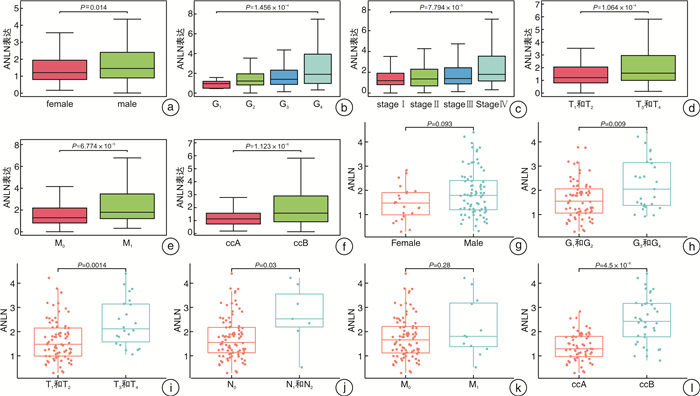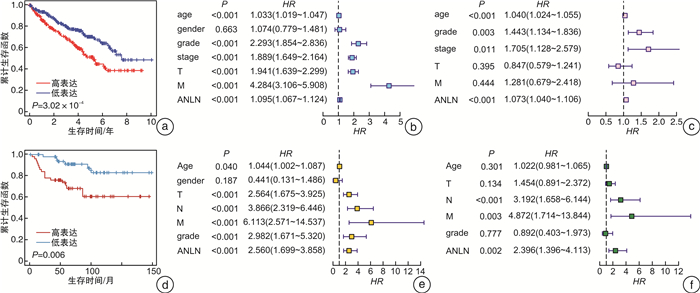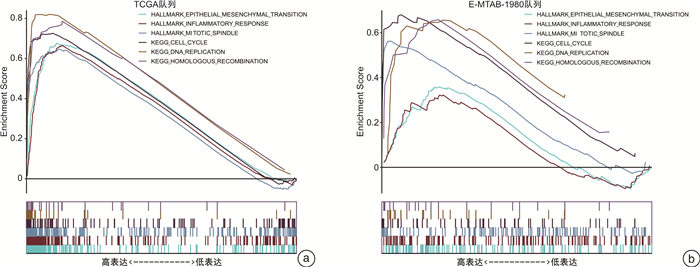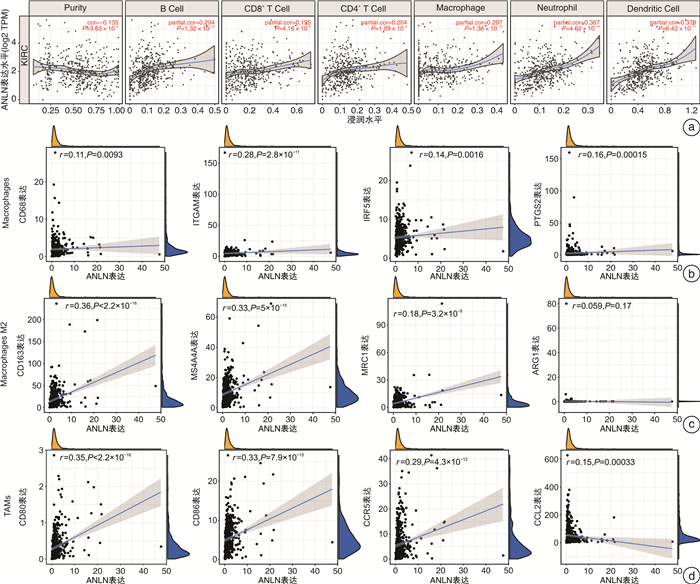ANLN as a novel clear cell renal cell carcinoma prognostic biomarker associated with immune cell infiltration
-
摘要: 目的 研究肌动蛋白结合蛋白(ANLN)在肾透明细胞癌(ccRCC)中的表达情况,分析其表达量与预后及免疫浸润的相关性。方法 用癌症基因组图谱(TCGA)的ccRCC的测序数据分析ANLN在ccRCC中的mRNA表达水平及其与临床病理特征和生存预后的关系,并用我院10对癌及癌旁组织进行实时荧光定量聚合酶链反应(qRT-PCR)验证。通过CPTAC数据库分析ANLN蛋白表达水平在癌和癌旁组织中的差异。通过人类蛋白质图谱数据库(HPA)比较ANLN在ccRCC和癌旁组织的免疫组化数据。通过基因集富集分析(GSEA),探索ANLN可能参与的生物学功能。此外,我们还利用外部数据集E-MTAB-1980对上述分析进行验证。最后通过TIMER数据库探索ANLN与免疫细胞的相关性。结果 TCGA数据库及CPTAC数据库分析与qRT-PCR结果均提示ANLN在ccRCC中高表达。且ANLN基因表达在不同性别、肿瘤病理分级、临床分期、T分期、M分期及不同分子亚型中均有显著差异。ANLN高表达的ccRCC患者预后不良,差异有统计学意义(P< 0.001)。单因素和多因素Cox回归分析显示,ANLN可以作为ccRCC的独立预后因子。GSEA分析表明,ANLN可能参与免疫反应等生物学过程。此外,ANLN表达量还与6种免疫细胞浸润水平存在显著相关性,其中与巨噬细胞相关性较高。结论 ANLN在ccRCC中的高表达与临床特征关系紧密,ANLN高表达的ccRCC患者预后差,且可以作为ccRCC的独立预后因子。此外,ANLN还与巨噬细胞的浸润水平存在相关性,提示其与肿瘤免疫微环境密切相关。Abstract: Objective To investigate the expression level of anillin actin-binding protein(ANLN) in clear cell renal cell carcinoma (ccRCC) and identify the correlation between ANLN expression and ccRCC prognosis and immune cell infiltration level.Methods The RNA-seq data and corresponding clinical information were obtained from the TCGA (the cancer genome atlas) database. Then, we analyzed the correlation between the mRNA expression level of ANLN and clinicopathological features, as well as overall survival time. Subsequently, 10 pairs of ccRCC samples from our center were used to carry out qRT-PCR experiment to further validate the relative expression of ANLN. CPTAC database was used to analyze the difference of ANLN protein expression between cancer and adjacent tissues. In addition, we compared the IHC figures between normal and tumor tissues obtained from the HPA (human protein atlas). Besides, the median expression of ANLN was set as the cut-off to separate samples into high and low ANLN expression groups. GSEA (Gene set enrichment analysis) was then performed to identify potential pathways in high ANLN expression group. In addition, we validate the above analysis using the external dataset E-MTAB-1980. Finally, the gene module in the TIMER (Tumor Immune Estimation Resource) database were used to investigate the correlation between ANLN expression and immune cell infiltration level.Results ANLN was significant overexpressed in ccRCC samples than normal samples in TCGA database (P< 0.001) and CPTAC database (P< 0.001). The qRT-PCR results from our center also confirmed that ANLN expression were relatively higher in the ccRCC tissues (P=0.0085) and IHC results from the HPA database also support the conclusion. In addition, there were significant differences between ANLN expression and clinicopathological features, such as gender, grade, clinical stages and T, M stage. Besides, the survival analysis showed that overexpression of ANLN was significantly associated with unfavorable prognosis (P< 0.001). Furthermore, the univariate and multivariate cox regression demonstrated that ANLN expression could function as an independent prognostic factor. Besides, the biological function of ANLN were correlated with immune response. Moreover, ANLN expression were significantly correlated with immune cell infiltrations including B cells, CD8+T/CD4+T cells, macrophages, neutrophils and dendritic cells.Conclusion The high expression of ANLN in ccRCC is closely related to the clinical characteristics. Higher expression of ANLN were not only correlated with poor prognosis but also could function as an independent prognostic factor. In addition, ANLN expression was also correlated with the infiltration level of immune cells, suggesting that ANLN was closely related to the tumor immune microenvironment.
-

-
[1] Sung H, Ferlay J, Siegel RL, et al. Global Cancer Statistics 2020: GLOBOCAN Estimates of Incidence and Mortality Worldwide for 36 Cancers in 185 Countries[J]. CA Cancer J Clin, 2021, 71(3): 209-249. doi: 10.3322/caac.21660
[2] Kang M, Park JY, Jeong CW, et al. Changeable Conditional Survival Rates and Associated Prognosticators in Patients with Metastatic Renal Cell Carcinoma Receiving First Line Targeted Therapy[J]. J Urol, 2018, 200(5): 989-995. doi: 10.1016/j.juro.2018.06.030
[3] 陈逸凡, 吕蔡. 铁死亡及其在肾癌中的研究进展。[J]. 临床泌尿外科杂志, 2022, 36(6): 474-477. https://www.cnki.com.cn/Article/CJFDTOTAL-LCMW202206015.htm
[4] Rini BI, Atkins MB. Resistance to targeted therapy in renal-cell carcinoma[J]. Lancet Oncol, 2009, 10(10): 992-1000. doi: 10.1016/S1470-2045(09)70240-2
[5] Ye DW, Zhang HL. Critical appraisal of sorafenib in the treatment of Chinese patients with renal cell carcinoma[J]. Onco Targets Ther, 2014, 7: 925-935.
[6] Braun DA, Hou Y, Bakouny Z, et al. Interplay of somatic alterations and immune infiltration modulates response to PD-1 blockade in advanced clear cell renal cell carcinoma[J]. Nat Med, 2020, 26(6): 909-918. doi: 10.1038/s41591-020-0839-y
[7] 王永富, 唐华, 陈剑, 等. PD-1抑制剂联合阿西替尼对转移性肾癌的治疗效果及安全性分析[J]. 临床泌尿外科杂志, 2022, 37(3): 180-183. https://www.cnki.com.cn/Article/CJFDTOTAL-LCMW202203005.htm
[8] Piekny AJ, Maddox AS. The myriad roles of Anillin during cytokinesis[J]. Semin Cell Dev Biol, 2010, 21(9): 881-891. doi: 10.1016/j.semcdb.2010.08.002
[9] Jia H, Yu F, Li B, et al. Actin-binding protein Anillin promotes the progression of gastric cancer in vitro and in mice[J]. J Clin Lab Anal, 2021, 35(2): e23635.
[10] Magnusson K, Gremel G, Rydén L, et al. ANLN is a prognostic biomarker independent of Ki-67 and essential for cell cycle progression in primary breast cancer[J]. BMC Cancer, 2016, 16(1): 904. doi: 10.1186/s12885-016-2923-8
[11] Long X, Zhou W, Wang Y, et al. Prognostic significance of ANLN in lung adenocarcinoma[J]. Oncol Lett, 2018, 16(2): 1835-1840.
[12] Chen S, Gao Y, Chen F, et al. ANLN Serves as an Oncogene in Bladder Urothelial Carcinoma via Activating JNK Signaling Pathway[J]. Urol Int, 2022.
[13] Wang Z, Hu S, Li X, et al. MiR-16-5p suppresses breast cancer proliferation by targeting ANLN[J]. BMC Cancer, 2021, 21(1): 1188. doi: 10.1186/s12885-021-08914-1
[14] Xu J, Zheng H, Yuan S, et al. Overexpression of ANLN in lung adenocarcinoma is associated with metastasis[J]. Thorac Cancer, 2019, 10(8): 1702-1709. doi: 10.1111/1759-7714.13135
[15] Ritchie ME, Phipson B, Wu D, et al. limma powers differential expression analyses for RNA-sequencing and microarray studies[J]. Nucleic Acids Res, 2015, 43(7): e47. doi: 10.1093/nar/gkv007
[16] Brooks SA, Brannon AR, Parker JS, et al. ClearCode34: A prognostic risk predictor for localized clear cell renal cell carcinoma[J]. Eur Urol, 2014, 66(1): 77-84. doi: 10.1016/j.eururo.2014.02.035
[17] Subramanian A, Tamayo P, Mootha VK, et al. Gene set enrichment analysis: a knowledge-based approach for interpreting genome-wide expression profiles[J]. Proc Natl Acad Sci U S A, 2005, 102(43): 15545-15550. doi: 10.1073/pnas.0506580102
[18] Wang D, Naydenov NG, Dozmorov MG, et al. Anillin regulates breast cancer cell migration, growth, and metastasis by non-canonical mechanisms involving control of cell stemness and differentiation[J]. Breast Cancer Res, 2020, 22(1): 3. doi: 10.1186/s13058-019-1241-x
[19] Ferlay J, Colombet M, Soerjomataram I, et al. Cancer incidence and mortality patterns in Europe: Estimates for 40 countries and 25 major cancers in 2018[J]. Eur J Cancer, 2018, 103: 356-387. doi: 10.1016/j.ejca.2018.07.005
[20] Ferlay J, Colombet M, Soerjomataram I, et al. Estimating the global cancer incidence and mortality in 2018: GLOBOCAN sources and methods[J]. Int J Cancer, 2019, 144(8): 1941-1953. doi: 10.1002/ijc.31937
[21] Makhov P, Joshi S, Ghatalia P, et al. Resistance to Systemic Therapies in Clear Cell Renal Cell Carcinoma: Mechanisms and Management Strategies[J]. Mol Cancer Ther, 2018, 17(7): 1355-1364. doi: 10.1158/1535-7163.MCT-17-1299
[22] Maryam A, Chin YR. ANLN Enhances Triple-Negative Breast Cancer Stemness Through TWIST1 and BMP2 and Promotes its Spheroid Growth[J]. Front Mol Biosci, 2021, 8: 700973. doi: 10.3389/fmolb.2021.700973
[23] Chen J, Li Z, Jia X, et al. Targeting anillin inhibits tumorigenesis and tumor growth in hepatocellular carcinoma via impairing cytokinesis fidelity[J]. Oncogene, 2022, 41(22): 3118-3130. doi: 10.1038/s41388-022-02274-1
[24] Tate JG, Bamford S, Jubb HC, et al. COSMIC: the Catalogue Of Somatic Mutations In Cancer[J]. Nucleic Acids Res, 2019, 47(D1): D941-D947. doi: 10.1093/nar/gky1015
[25] Holopainen S, Hytönen MK, Syrjä P, et al. ANLN truncation causes a familial fatal acute respiratory distress syndrome in Dalmatian dogs[J]. PLoS Genet, 2017, 13(2): e1006625. doi: 10.1371/journal.pgen.1006625
[26] Arcaroli JJ, Liu N, Yi N, et al. Association between IL-32 genotypes and outcome in infection-associated acute lung injury[J]. Crit Care, 2011, 15(3): R138. doi: 10.1186/cc10258
[27] Dame TM, Orenzoff BL, Palmer LE, et al. IFN-gamma alters the response of Borrelia burgdorferi-activated endothelium to favor chronic inflammation[J]. J Immunol, 2007, 178(2): 1172-1179. doi: 10.4049/jimmunol.178.2.1172
[28] Chakiryan NH, Kimmel GJ, Kim Y, et al. Spatial clustering of CD68+ tumor associated macrophages with tumor cells is associated with worse overall survival in metastatic clear cell renal cell carcinoma[J]. PLoS One, 2021, 16(4): e0245415. doi: 10.1371/journal.pone.0245415
[29] Ma C, Komohara Y, Ohnishi K, et al. Infiltration of tumor-associated macrophages is involved in CD44 expression in clear cell renal cell carcinoma[J]. Cancer Sci, 2016, 107(5): 700-707. doi: 10.1111/cas.12917
-




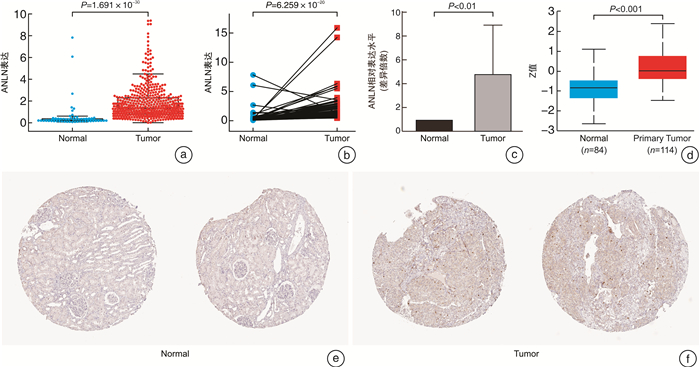
 下载:
下载:
